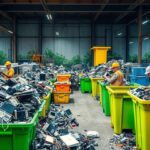The global fashion industry is at a critical turning point. Every year, 56 million tonnes of clothing are bought worldwide, and this number could jump to 160 million tonnes by 2050. I’m exploring the dark truth about fast fashion and sustainable options that can change how we dress.
Fast fashion is a global environmental disaster. It’s the second-most polluting industry, creating 1 to 2.1 billion tonnes of CO2 annually. A single cotton T-shirt requires 2,700 liters of water, enough for one person to drink for two and a half years.
My research shows the harsh reality behind cheap, trendy clothes. The costs to the environment and people are enormous. Fast fashion is about making money, not caring for our planet or workers.
Sustainable fashion is more than a trend; it’s a needed change. By knowing how our clothes affect the world, we can choose better. This article will help you understand fashion better and find ethical, green options.
It’s time to change how we dress and think. The clothes we wear tell a story. Let’s choose a story of responsibility, sustainability, and authentic style.
Understanding Fast Fashion’s Global Impact
The fashion industry is at a turning point. Fast fashion brands are causing big environmental and social problems. I’ll look into how these issues affect more than just clothes.
The global garment industry is having a staggering impact on our environment, and it’s time for us to take urgent action.
The statistics are truly alarming:
- 10% of global carbon emissions come from fashion production.
- 85% of textiles end up in landfills annually.
- 500,000 tons of microfibers pollute oceans each year.
The Environmental Cost of Rapid Production
Fast fashion’s harm to the environment is severe. Textile manufacturing generates a lot of pollution, with dyeing and finishing causing 36% of the damage.
The fast production cycle leads to:
- Zara produces new designs in 2 weeks.
- Shein launches 1,000 new styles daily.
- Approximately 80 billion new clothing pieces consumed annually.
Social Impact on Garment Workers
UN Report,
One in six people worldwide depends on the fashion industry for employment.
Every cheap garment has a human story behind it. Workers, mostly young women, face tough conditions with low pay and health risks.
Economic Implications for Local Communities
Fast fashion hurts local textile economies. Traditional manufacturing sectors face tough competition from global mass production. This causes big economic changes in developing areas.
The current fashion model is not sustainable. We need to change how we make, use, and value clothes.
The Evolution of Disposable Fashion Culture
Fashion has changed a lot in recent years. What used to be a well-thought-out wardrobe is now all about fast buying and quick changes. Fashion trends now come and go almost every day.
Disposable Fashion Trends
Numbers show how big this change is. Global clothing production has surged by 50% in just 15 years. Today, people buy 100 billion clothing items every year. This shows a big change in how we see clothes. Fight Club stayed,
We buy things we don’t need, with money we don’t have, to impress people we don’t like.
What’s driving this fast fashion culture? There are a few main reasons:
- Rapid technological advancements in manufacturing.
- Ultra-low pricing strategies.
- Constant social media influence.
- Increased accessibility of online shopping.
But there’s a growing push for conscious consumption. People are starting to think more about the impact of their clothes. The average person buys 11.4 kg of clothes each year. And these clothes are often worn just 5-7 times before being thrown away.
The economic side of this is huge. Clothing sales worldwide are expected to jump from $1 trillion in 2002 to $2.1 trillion by 2025. This shows the disposable fashion culture is here to stay.
Fashion Consumption Trends
Looking ahead, we face a big challenge. We need to find a way to enjoy new fashion trends while also being sustainable and ethical in our choices.
Environmental Devastation: Water Usage and Pollution
The fashion industry is quietly harming our planet’s most vital resource: water. My research uncovered disturbing facts about how clothes are made and how they affect our water systems.
Textile manufacturing uses an enormous amount of water. The industry consumes 93 billion cubic meters of water annually. This makes it the second-largest water user, after farming.
Textile Dyeing and Water Contamination
Dyeing clothes poses a significant challenge to our environment, and it’s crucial to understand the impact it has.
Here are some key points to consider:
- It’s responsible for 20% of global industrial water pollution.
- It releases harmful chemicals like copper, mercury, and chromium.
- It creates wastewater full of dangerous substances.
Global Water Research Institute,
One cotton shirt requires approximately 700 gallons of water to produce.
Microplastic Pollution from Synthetic Fabrics
Synthetic fabrics also cause a big environmental issue. Up to 85% of pollution on shorelines comes from microfibres. About 500,000 tonnes of microfibres are dumped into oceans every year.
Impact on Global Water Resources
Water impact metric and statistic chart:
| Water Impact Metric | Statistic |
| Annual Water Consumption | 93 billion cubic meters. |
| Wastewater Production | 20% of global industrial wastewater. |
| Potential Water Savings | 218 billion liters by switching to organic cotton. |
Knowing these facts helps us make better choices. Our clothes choices affect our planet’s water systems. We can all play a part in reducing waste and protecting our water.
Fast Fashion Giants and Their Business Models
Fast fashion brands have changed the clothing world with their quick production and focus on trends. Companies like Zara, H&M, and Uniqlo have made clothes cheaper and faster, but at a cost to the environment.
Fast Fashion Brands Business Models
Let’s look at what makes these fast fashion giants stand out:
- Zara can design, produce, and deliver a new garment in just two weeks.
- H&M completes its production cycle in approximately eight weeks.
- Shein, a newer player, can prepare garments for sale in just 10 days.
These brands’ success comes from making trends fast and affordable. Zara, for example, makes 12,000 new designs and over 450 million clothes every year. This keeps their stores full of new items and keeps customers coming back. Unknown,
Speed is the new currency of business.
Is Zara fast fashion? Yes. Is Uniqlo fast fashion? Definitely. They’ve created a system that makes lots of clothes cheaply. Uniqlo, with over 3,000 stores worldwide, always has new items and keeps costs low.
The downside of this model is big. Fast fashion creates about 92 million tonnes of waste every year. This number could go up to 134 million tonnes by 2030.
The Human Cost: Labor Exploitation and Working Conditions
The world of ethical clothing is marred by human suffering. Millions of workers face harsh conditions in the global garment industry. This is a reality that needs to be acknowledged.
Garment Industry Workers Conditions
Sweatshop Labor and Safety Risks
In countries like Bangladesh, workers earn just 33 cents an hour. In India, they get about 58 cents. These wages are barely enough to survive, leading to dangerous work environments. Labor rights advocate,
The clothes we wear come with a hidden human cost that most consumers never see.
Wage Disparities and Exploitation
- Less than 2% of garment workers earn a living wage.
- Workers often work 14-16 hours daily, seven days a week.
- Minimum wages cover only 20-50% of family necessities.
Child Labor in the Supply Chain
Child labor is a dark part of the garment industry. In India, 60% of workers were under 18 when they started. About 80% of workers are women, mostly between 18-35 years old.
The Rana Plaza factory collapse in 2013 killed 1,134 people. It’s a tragic reminder of the industry’s neglect of worker safety for cheap clothes.
Pandemic Impact on Workers
COVID-19 made things worse for workers in the ethical clothing sector. Brands canceled $40 billion in orders, causing huge layoffs. Wages fell by 11%, and over a million workers, mostly women, lost their jobs.
I urge consumers to think about the people behind their clothes. Let’s make choices that support fair labor practices.
Carbon Footprint and Climate Change Impact
The fashion world quietly adds to global warming, with a growing carbon footprint. Fast fashion is now responsible for 10% of global carbon emissions each year. This is more than flights and ships combined.
Fast Fashion Environmental Impact
Let’s look at the environmental harm caused by this industry:
- Greenhouse gas emissions are expected to rise by over 50% by 2030.
- A single polyester t-shirt creates 5.5 kg CO2e emissions.
- By 2050, fashion could be responsible for 26% of global carbon emissions.
Climate Research Institute,
The clothes we wear are quietly shaping our planet’s future.
The carbon footprint of fast fashion goes beyond just making clothes. It also includes transportation, manufacturing, and how quickly we use and throw away clothes.
Production stage and carbon emissions impact chart:
| Production Stage | Carbon Emissions Impact |
| Raw Material Extraction | 35% Of total emissions. |
| Manufacturing | 25% Of total emissions. |
| Transportation | 20% Of total emissions. |
| Consumer Use | 15% Of total emissions. |
| End of Life Disposal | 05% Of total emissions. |
My research shows that our choices can greatly reduce fashion’s harm to the environment. By making clothes last longer, choosing eco-friendly materials, and buying less, we can make a big difference.
The Rise of Sustainable Fashion Alternatives
The fashion world is changing fast. People now know how clothes harm the planet and society. So, sustainable fashion is becoming a big deal, unlike the old fast fashion.
Sustainable Fashion Alternatives
I’ve seen a big change in the fashion world. The slow fashion movement is making clothes better. It values quality, fair making, and caring for the planet.
Slow Fashion Movement Principles
- Prioritize quality over quantity.
- Support ethical manufacturing practices.
- Reduce overall clothing consumption.
- Invest in long-lasting garments.
Ethical Manufacturing Practices
Ethical clothing brands are changing the game.
They focus on:
- Fair wages for workers
- Safe working conditions
- Transparent supply chains
- Reduced environmental impact
Fashion sustainability expert,
Sustainable fashion isn’t just a trend, it’s a necessary revolution in how we think about clothing.
Sustainable Material Innovations
The sustainable fashion movement is leading to new materials. Designers are making clothes with fabrics that are kinder to the planet.
Sustainable fabric, environmental benefits and water usage reduction chart:
| Sustainable Fabric | Environmental Benefits | Water Usage Reduction |
| Organic Cotton | Reduces pesticide use | Up to 91% less water. |
| Recycled Polyester | Diverts plastic from landfills | 59% lower carbon emissions. |
| Hemp | Requires minimal water | Zero chemical pesticides. |
Choosing sustainable fashion is more than just picking clothes. It’s part of a global effort towards better fashion. Every choice we make helps change the way we make and use clothes.
Consumer Responsibility and Mindful Shopping
As a conscious consumer, I’ve learned that our shopping choices have big impacts. The fashion industry creates a lot of waste. The average person buys 60% more clothes than 15 years ago but keeps them for half as long.
Ethical clothing is not just a trend; it is a crucial way to reduce environmental damage.
Here are some tips for mindful shopping:
- Check if brands are sustainable before buying.
- Choose quality over quantity.
- Buy pieces that last a long time.
- Learn about how clothes are made.
Statistics show the shocking truth about fashion’s impact. About 92 million tons of textile waste are made each year. Only 1% of clothes are recycled into new ones. By choosing wisely, we can cut down our fashion waste a lot. Unknown,
Every purchase is a vote for the kind of world you want to live in.
Here are some easy steps to make fashion more sustainable:
- Build a small wardrobe.
- Swap clothes with others.
- Fix and care for your clothes.
- Support brands that are open and fair.
Research shows 73% of young people want to buy things that are good for the planet. By choosing to buy mindfully, we can change the fashion world, one choice at a time.
Circular Fashion: Reducing Textile Waste
The fashion world is at a turning point. In 2018, the U.S. generated nearly 17 million tons of textile waste. Only 15% was recycled or reused. This is an environmental crisis that needs new solutions.
Circular fashion is a new way to tackle textile waste. It changes how we make, use, and throw away clothes. This approach aims to make our fashion world more sustainable and reduce harm to the environment.
Recycling and Upcycling Initiatives
Exciting new recycling methods are emerging to tackle the pressing issue of textile waste! These innovative approaches aim to transform how we manage our clothing and enhance sustainability in the fashion industry.
Let’s explore some of the groundbreaking efforts that are making a difference:
- Turning old clothes into new ones.
- Making new fabrics from recycled materials.
- Creating advanced ways to recycle textiles.
Second-hand Market Growth
The second-hand clothing market is growing fast. More people are choosing to buy used clothes instead of new ones. This is seen as a greener option than fast fashion.
One person’s discard is another’s treasure – and potentially a climate solution.
Rental Fashion Solutions
Fashion rental services are changing how we use clothes. They let people wear high-quality items for a short time. This cuts down on the waste each person creates.
Circular fashion strategy and waste reduction potential:
| Circular Fashion Strategy | Waste Reduction Potential |
| Clothing Recycling | Up to 40% reduction in textile waste. |
| Second-hand Market | Extends garment lifecycle by 2-3 times. |
| Fashion Rental | Reduces individual clothing consumption by 50%. |
By adopting circular fashion, we can change the fashion industry’s environmental impact. This will help create a greener future for fashion.
Greenwashing in the Fashion Industry
Fast fashion brands often pretend to be eco-friendly through greenwashing. They use fancy marketing to make it seem like they care about the planet. But, they keep doing harm.
Greenwashing in sustainable fashion is a pressing issue that deserves our attention. Did you know that many brands are claiming to be eco-friendly while not making real changes?
Here are some eye-opening facts that reveal the extent of the problem:
- About 50% of global consumers don’t believe what clothing brands say about being green.
- In 2022, Decathlon was fined $530,000 for making false environmental claims.
- H&M got a $430,500 penalty for lying about their green marketing.
Fashion transparency report,
Green marketing has become a smokescreen for continued environmental damage.
To effectively identify greenwashing, it’s essential to scrutinize the claims made by fast fashion brands with a critical eye. Keep your radar up for inconsistencies and red flags!
Here are some key things to look for:
- Vague terms about being green.
- No clear certifications.
- Little to no real changes in how they make clothes.
Brand, greenwashing claim and actual impact chart:
| Brand | Greenwashing Claim | Actual Impact |
| Shein | False ISO Certification | Unverified Environmental Practices. |
| Lululemon | “Be Planet” Campaign | Doubled Greenhouse Gas Emissions. |
| Walmart | Bamboo Textile Claims | $3 Million FTC Penalty. |
Being aware as consumers is key to fighting greenwashing in fashion. By asking for real change and transparency, we can make fast fashion brands act responsibly for the planet.
Building a Sustainable Wardrobe
Creating a sustainable wardrobe is more than a trend. It’s a way to lessen your environmental footprint. The fashion world is a big polluter, with clothes and textiles adding to global carbon emissions.
Quality Over Quantity: A Mindful Approach
Sustainable fashion means making thoughtful choices. It’s about picking pieces that will stand the test of time. By wearing each item more, you can cut down on waste by 60%.
Capsule Wardrobe Basics
Imagine a wardrobe that completely changes how you see your clothing! A capsule wardrobe has the power to do just that.
Here are some key tips for creating a versatile collection:
- Choose timeless, neutral-colored pieces.
- Select high-quality, durable materials.
- Prioritize non fast fashion brands with transparent supply chains.
- Invest in multipurpose garments.
Smart Investment Piece Selection
When looking into sustainable fashion, keep these key factors in mind. Here are essential tips to help you discover stylish, eco-friendly pieces that not only look fantastic but also support the planet!
They include:
- Durability of fabric.
- Versatility in styling.
- Ethical manufacturing practices.
- Potential for multiple uses.
Patsy Perry, University of Manchester,
Less is always more.
By following these guidelines, you’ll not only cut down on waste. You’ll also build a wardrobe that shows off your style and values.
Conclusion
Fast fashion poses big environmental and social problems. The fashion industry is a huge polluter, even bigger than aviation and shipping. It’s expected to get even worse, with emissions going up by 60% by 2030.
Our clothes are made to be worn less and less. Clothing sales are doubling every year. Yet, we wear each item less than before, by over 30%.
Sustainable fashion is key to solving these issues. By choosing clothes made ethically, we can lessen the industry’s harm. Most clothes are made from plastic, leading to huge pollution problems.
Every time we wash clothes, we release millions of plastic microfibers. Sadly, 94% of U.S. tap water now has microplastics. This shows we need to act fast.
Every time we buy clothes, we’re voting for the world we want. Fast fashion is expected to grow to $40 billion by 2025. But we can change this.
By supporting brands that make clothes sustainably, we can make a difference. We can also buy fewer clothes and choose quality over quantity. Our choices can change the industry for the better.
Our path to a better fashion future starts with being aware and taking action. Let’s embrace slow fashion and support fair manufacturing. Together, we can make a big change.
Frequently Ask Questions (FAQ)
What exactly is fast fashion?
Fast fashion is about cheap clothes made quickly by big stores to follow the latest trends. Brands like Zara, H&M, and UNIQLO make trendy, affordable clothes. These clothes are meant to be worn briefly and then thrown away, causing big environmental and social issues.
How does fast fashion impact the environment?
Fast fashion harms the environment a lot. It uses a lot of water, creates a lot of carbon emissions, and produces a lot of waste. The industry is a big polluter and uses a lot of water, making it a huge problem.
Why are fast fashion clothes so cheap?
Fast fashion brands keep prices low by cutting costs. They use cheap materials, exploit workers in poor countries, and make lots of clothes quickly. This way, they make more money but ignore worker rights and the environment.
What are the human rights issues in fast fashion?
Fast fashion is known for bad working conditions. Workers face dangerous factories, low pay, long hours, and even child labor. Many workers in places like Bangladesh and Cambodia are exploited and work in unsafe places for little money.
How can I transition to more sustainable fashion?
Start by creating a small wardrobe with quality pieces. Look for ethical brands and second-hand clothes. Learn to repair your clothes and think carefully about what you buy. Choose brands that care about the planet and workers.
What are some reliable sustainable fashion brands?
Good sustainable fashion brands include Patagonia, Everlane, Reformation, Eileen Fisher, and Organic Basics. These brands focus on making clothes the right way, use green materials, and are open about where they make their clothes.
How does textile waste impact the environment?
Textile waste is a big problem for the environment. Most clothes end up in landfills and take a long time to break down. Synthetic fabrics also pollute water and harm marine life.
What is the slow fashion movement?
The slow fashion movement is about making clothes better for the planet and people. It’s about making clothes that last, treating workers fairly, and using less. It’s against the fast fashion idea of throwing things away quickly.
How can consumers identify greenwashing?
To spot greenwashing, look for clear, true claims about being green. Check for third-party certifications and research the brand’s real practices. Be wary of vague claims and marketing that seems too good to be true.
What are the economic implications of fast fashion?
Fast fashion hurts local textile industries and pushes costs down globally. It also creates economic problems and unfairness. It often hurts traditional crafts and local businesses in countries where clothes are made.






















